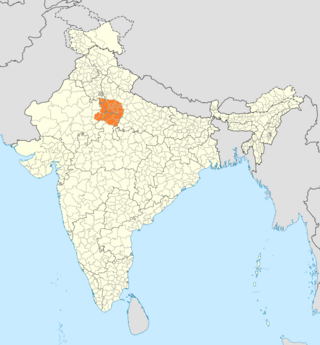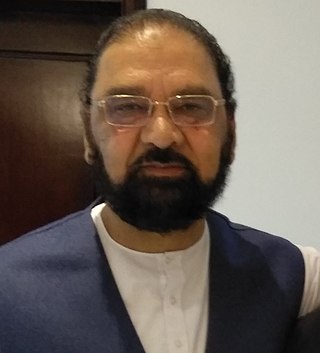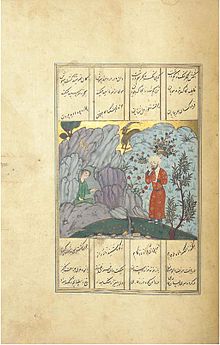
Abu'l Hasan Yamīn ud-Dīn Khusrau, better known as Amīr Khusrau, was an Indo-Persian Sufi singer, musician, poet and scholar who lived during the period of the Delhi Sultanate.

Sultan-ul-Mashaikh, Khwaja Syed Muhammad Nizamuddin Auliya, also known as Hazrat Nizamuddin, and Mahbub-e-Ilahi was an Indian Sunni Muslim scholar, Sufi saint of the Chishti Order, and is one of the most famous Sufis from the Indian Subcontinent. His predecessors were Fariduddin Ganjshakar, Qutbuddin Bakhtiyar Kaki, and Moinuddin Chishti, who were the masters of the Chishti spiritual chain or silsila in the Indian subcontinent.

"Hasht-Bihisht" is a famous poem written by Amir Khusrow around 1302 AD. The poem is based on the Haft Paykar by Nizami, written around 1197 AD, which in turn takes its outline from the earlier epic Shahnameh written by Firdausi around 1010 AD. Like Nizami's Haft Paykar, Khusrow's Hasht Bihisht uses a legend about Bahram V Gur as its frame story and, in the style of One Thousand and One Nights, introduces folktales told by seven princesses. Most famously, Khusrow appears to be the first writer to have added The Three Princes of Serendip as characters and the story of the alleged camel theft and recovery.

Qutb-ud-din Mubarak Shah also known as Ikhtiyar al-Din, was a ruler of the Delhi Sultanate of present-day India. A member of the Khalji dynasty, he was a son of Alauddin Khalji.

The Braj language, Braj Bhasha, also known as Vraj Bhasha or Brij Bhasha or Braj Boli, is a Western Hindi language. Along with Awadhi, it was one of the two predominant literary languages of North-Central India before the switch to Hindustani in the 19th century.

Padmini, also known as Padmavati, was a 13th–14th century Rani (queen) of the Mewar kingdom of present-day India. Several medieval texts mention her, although these versions are disparate and many modern historians question the extent of overall authenticity.

Rekhta was an early form of the Hindustani language. This style evolved in both the Perso-Arabic and Devanagari scripts and is considered an early form of Modern Standard Urdu and Modern Standard Hindi. According to the Pakistani linguist and historian Tariq Rehman, Rekhta was a highly Persianized register of Hindustani, exclusively used by poets. It was not only the vocabulary that was Persianized, but also the poetic metaphors, inspired by Indian landscapes and seasons, were abandoned in favor of the Persian ones i.e. bahaar (spring) replacing barsaat.

Gopi Chand Narang was an Indian theorist, literary critic, and scholar who wrote in Urdu and English. His Urdu literary criticism incorporated a range of modern theoretical frameworks including stylistics, structuralism, post-structuralism, and Eastern poetics.
Ustad Bahauddin Khan Qawwal was a Pakistani Qawwali musician.
Aaj Rang Hai also known as Rang or Rung (transl. Color) is a Qawwali written by the 13th-century Sufi poet, Amir Khusrau in Hindavi and Braj Bhasha dialects. In the song, Khusrau describes to his mother his ecstasy upon finding his murshid in the Sufi saint Nizamuddin Auliya. The song is a staple of most Qawwali sessions in North India and Pakistan, especially in the Chishti shrines of Delhi. It is traditionally sung as a closing piece at the end of a Qawwali session.
Nazir Ahmed (1915-2008) was an Indian scholar, writer, and teacher of the Persian language. He was honoured by the Indian Government in 1987 with the Padma Shri. He received this award for his contributions to the propagation of Persian Language and literature.

The siege of Chittorgarh occurred in 1303, when the Khalji ruler Alauddin Khalji captured and sacked the Chittor Fort, toppling the Guhila king Ratnasimha, after an eight-month-long siege. The conflict has been described in several legendary accounts, including the historical epic poem Padmavat, which claims that Alauddin's motive was to obtain Ratnasimha's beautiful wife Padmini; though this legend is considered historically inaccurate by most historians. Alauddin ordered the fort to be pelted with stones from his siege engines (munjaniqs). When the fort was stormed, Rajput women committed Jauhar while most of the warriors died defending the fort. The city of Chittor was completely sacked by Alauddin's army and several temples were desecrated.

The year-riddle is one of the most widespread, and apparently most ancient, international riddle-types in Eurasia. This type of riddle is first attested in Vedic tradition thought to originate in the second millennium BCE.
Ankit Chadha was an Indian writer, story-teller, oral narrative performance artist, researcher and educator. He specialized in research-based narratives performed in the centuries-old Dastangoi form of storytelling. His writing varied from biographical accounts of personalities like Kabir and Rahim to Dara Shikoh and Majaz. He had spoken on Dastangoi globally, including at Harvard, Yale and University of Toronto.

Mohammad Nawaz Khan is an Indian Urdu language poet. He is also a Ghazal writer some of them are sung by famous Ghazal singer Jagjit Singh. He wrote the lyrics for the Ghazal album Amaanat released by singer Sachin Sharma in 2008.
Paul E. Losensky is Professor of Comparative Literature and Adjunct Professor of Middle Eastern Languages and Cultures at Indiana University. He received his PhD in Near Eastern Languages and Civilizations from the University of Chicago in 1993. Losensky specializes in Persian literature and literary history.
The Iskandarnameh of Nizami, not to be confused with the anonymous Iskandarnameh, is a poetic production in the Alexander Romance tradition authored by the Persian poet Nizami Ganjavi that describes Alexander the Great as an idealized hero, sage, and king. More uniquely, he is also a seeker of knowledge who debates with great philosophers Greek and Indian philosophers, one of them being Plato.
The Ayina-i Iskandarī is a Persian legend of the life and exploits of Alexander the Great composed by the poet Amir Khusrau, completed in 1299/1300 during the reign of Muhammad II of Khwarazm. It is presented in the form of 35 discourses, running at 4,416 verses in the 1977 edition of the text produced by Jamâl Mirsaydof. Like his predecessor Nizami Ganjavi, Amir Khusrau's Alexander legend formed the fourth part of his Khamsa, and it was the first response to Nizami's Iskandarnameh. The text expresses a wish for the peace and stability brought about by Alexander as opposed to the period of instability and political turnover of his own time, and makes frequent reference to the "second Alexander" as a means of addressing his ruler Muhammad II, who assumed that title for himself during his reign.












